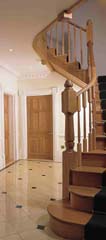Building Applications
8. Stairs
|
The availability of MDF in a wide range of thicknesses makes it suitable for each of the component parts of a complete stair construction. |
 |
General recommendations cannot be given for the thickness of MDF used for the treads for stairs constructed without full depth risers without reference to the safety requirements of national standards for this type of stair. The flatness and high stability of MDF in respect to changes in ambient conditions makes it a good material for wide treads, particularly those which are angled to carry the stairs round a bend. The front edges can easily be bullnosed as a safety feature. Rigidity of fixing and freedom from creaking is achieved by the use of adhesive bonded wedges used in conjunction with solid wood stringers. When using MDF stringers, improved stability is obtained if the treads are additionally supported by solid wood blocks or metal angle plates. The high density of MDF compared with solid wood has a damping effect on any vibration and hence any drumming.
The use of moisture resistant MDF can be advantageous, for stair components which are likely to be fitted before the building has dried out.
The higher modulus of elasticity and bending strength of high density MDF can be used to good advantage for the manufacture of stair treads and stringers with a higher performance specification. As the undersides of MDF stairs are not likely to be sealed, the use of low formaldehyde MDF is considered to be desirable; in some countries, its use is mandatory.












